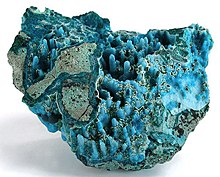| Chrysocolla | |
|---|---|
 Chrysocolla specimen from Ray mine, in the Scott Mountain area of Mineral Creek District, Pinal County, Arizona, US | |
| General | |
| Category | Phyllosilicate minerals, mineraloids |
| Formula (repeating unit) | Cu2 − xAlx(H2Si2O5)(OH)4·nH2O (x < 1)[1] |
| IMA symbol | Ccl[2] |
| Strunz classification | 9.ED.20 |
| Crystal system | Orthorhombic Unknown space group |
| Unit cell | a = 5.7 Å, b = 8.9 Å, c = 6.7 Å; Z = 1 |
| Identification | |
| Color | Blue, cyan (blue-green), green, dark blue to black, brown, rarely yellow |
| Crystal habit | Massive, nodular, botryoidal |
| Cleavage | none |
| Fracture | Irregular/uneven, sub-conchoidal |
| Tenacity | Brittle to sectile |
| Mohs scale hardness | 2.5–3.5 (7 for chrysocolla chalcedony, high-silica content) |
| Luster | Vitreous to dull |
| Streak | White to a blue-green color |
| Diaphaneity | Translucent to opaque |
| Specific gravity | 1.9–2.4 |
| Optical properties | Biaxial (−) |
| Refractive index | nα = 1.575–1.585 nβ = 1.597 nγ = 1.598–1.635 |
| Birefringence | δ = 0.023–0.050 |
| References | [3][4][1][5] |
Chrysocolla (/ˌkrɪsəˈkɒlə/ KRIS-ə-KOL-ə) is a hydrous copper phyllosilicate mineral and mineraloid with the formula Cu
2 – xAl
x(H
2Si
2O
5)(OH)
4⋅nH
2O (x < 1)[1] or (Cu, Al)
2H
2Si
2O
5(OH)
4⋅nH
2O).[4]
The structure of the mineral has been questioned, as a 2006 spectrographic study suggest material identified as chrysocolla may be a mixture of the copper hydroxide spertiniite and chalcedony.[6]
Chrysocolla typically forms amorphously.[7]
- ^ a b c Chrysocolla, Mindat.org
- ^ Warr, L. N. (2021). "IMA–CNMNC approved mineral symbols". Mineralogical Magazine. 85 (3): 291–320. Bibcode:2021MinM...85..291W. doi:10.1180/mgm.2021.43. S2CID 235729616.
- ^ "Chrysocolla". Mineralienatlas – Fossilienatlas.
- ^ a b "Chrysocolla" (PDF). Handbook of Mineralogy.
- ^ Chrysocolla Mineral Data, WebMineral.com
- ^ Cite error: The named reference
farges2006was invoked but never defined (see the help page). - ^ Chen, Chermaine (2021-09-02). "Chrysocolla Stone: Meaning, Uses & Other Facts about this Blue Green Crystal". The Gem Library. Retrieved 2024-07-25.